Organisational Behaviour Report: A.W. Holding, Semester 1, 2024
VerifiedAdded on 2020/10/05
|15
|4425
|473
Report
AI Summary
This report examines the principles of organisational behaviour within A.W. Holding Company Limited, a mechanical/industrial engineering firm. It delves into the influence of organisational culture, power dynamics, and politics on employee behaviour, utilizing Handy's organisational culture model and French and Raven's power framework to analyze these impacts. The report also assesses the effectiveness of process and content theories of motivation, including Vroom's Expectancy Theory, Adams' Equity Theory, goal-setting, reinforcement theory, Maslow's Hierarchy of Needs, Herzberg's theory, McClelland's theory, and Alderfer's ERG theory, in achieving company objectives. Additionally, the report explores strategies for developing effective teams, contributing to a comprehensive understanding of organisational behaviour and its practical applications within a business context.
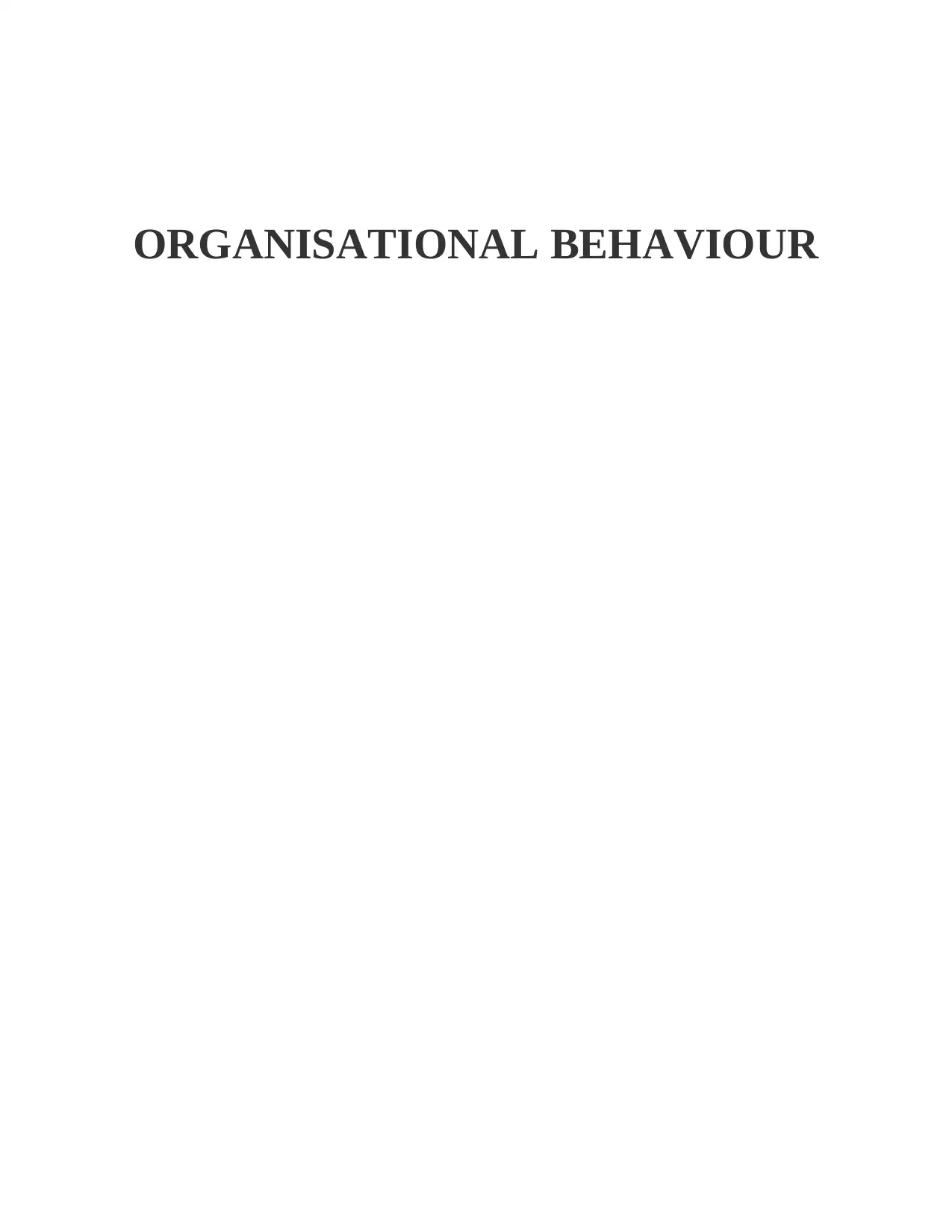
ORGANISATIONAL BEHAVIOUR
Paraphrase This Document
Need a fresh take? Get an instant paraphrase of this document with our AI Paraphraser
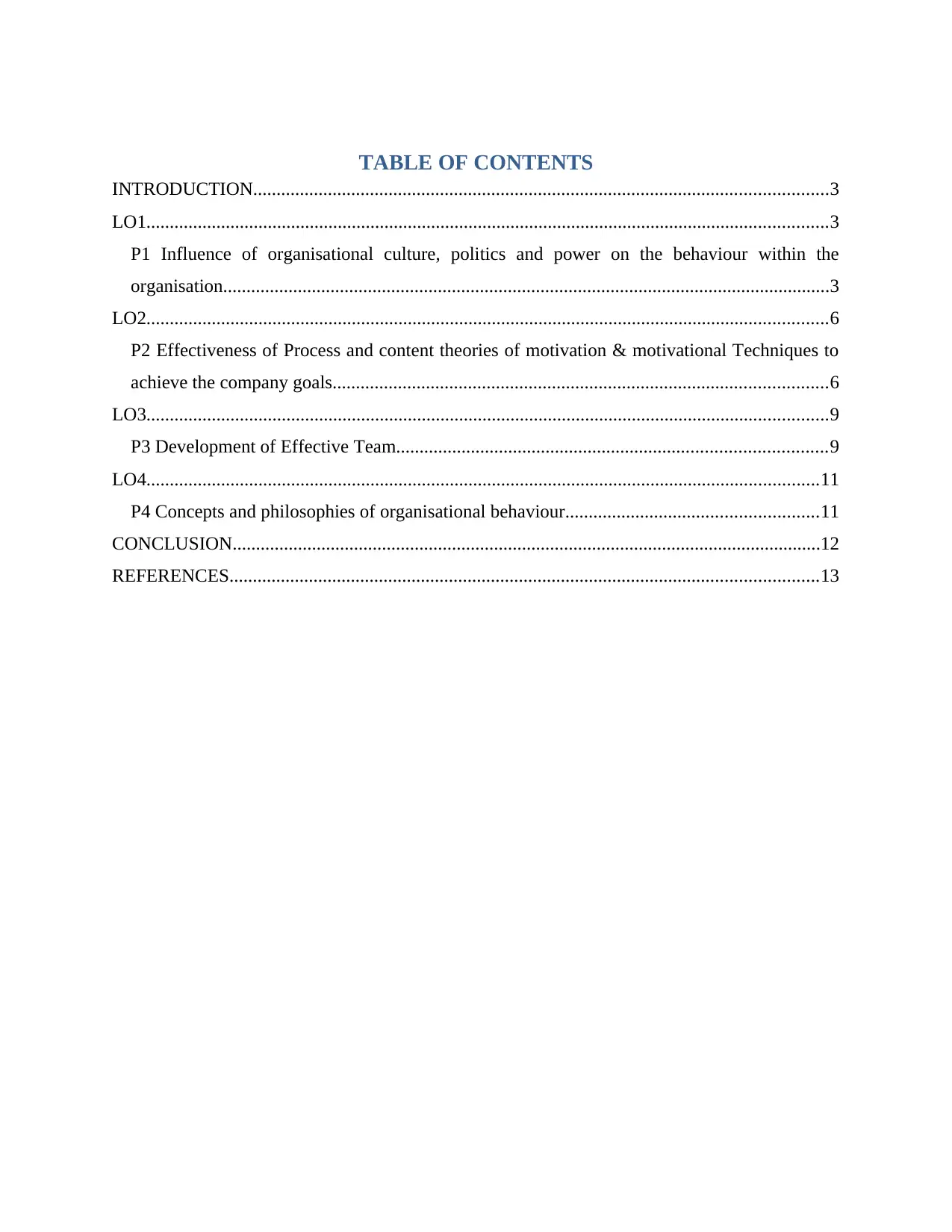
TABLE OF CONTENTS
INTRODUCTION...........................................................................................................................3
LO1..................................................................................................................................................3
P1 Influence of organisational culture, politics and power on the behaviour within the
organisation..................................................................................................................................3
LO2..................................................................................................................................................6
P2 Effectiveness of Process and content theories of motivation & motivational Techniques to
achieve the company goals..........................................................................................................6
LO3..................................................................................................................................................9
P3 Development of Effective Team............................................................................................9
LO4................................................................................................................................................11
P4 Concepts and philosophies of organisational behaviour......................................................11
CONCLUSION..............................................................................................................................12
REFERENCES..............................................................................................................................13
INTRODUCTION...........................................................................................................................3
LO1..................................................................................................................................................3
P1 Influence of organisational culture, politics and power on the behaviour within the
organisation..................................................................................................................................3
LO2..................................................................................................................................................6
P2 Effectiveness of Process and content theories of motivation & motivational Techniques to
achieve the company goals..........................................................................................................6
LO3..................................................................................................................................................9
P3 Development of Effective Team............................................................................................9
LO4................................................................................................................................................11
P4 Concepts and philosophies of organisational behaviour......................................................11
CONCLUSION..............................................................................................................................12
REFERENCES..............................................................................................................................13
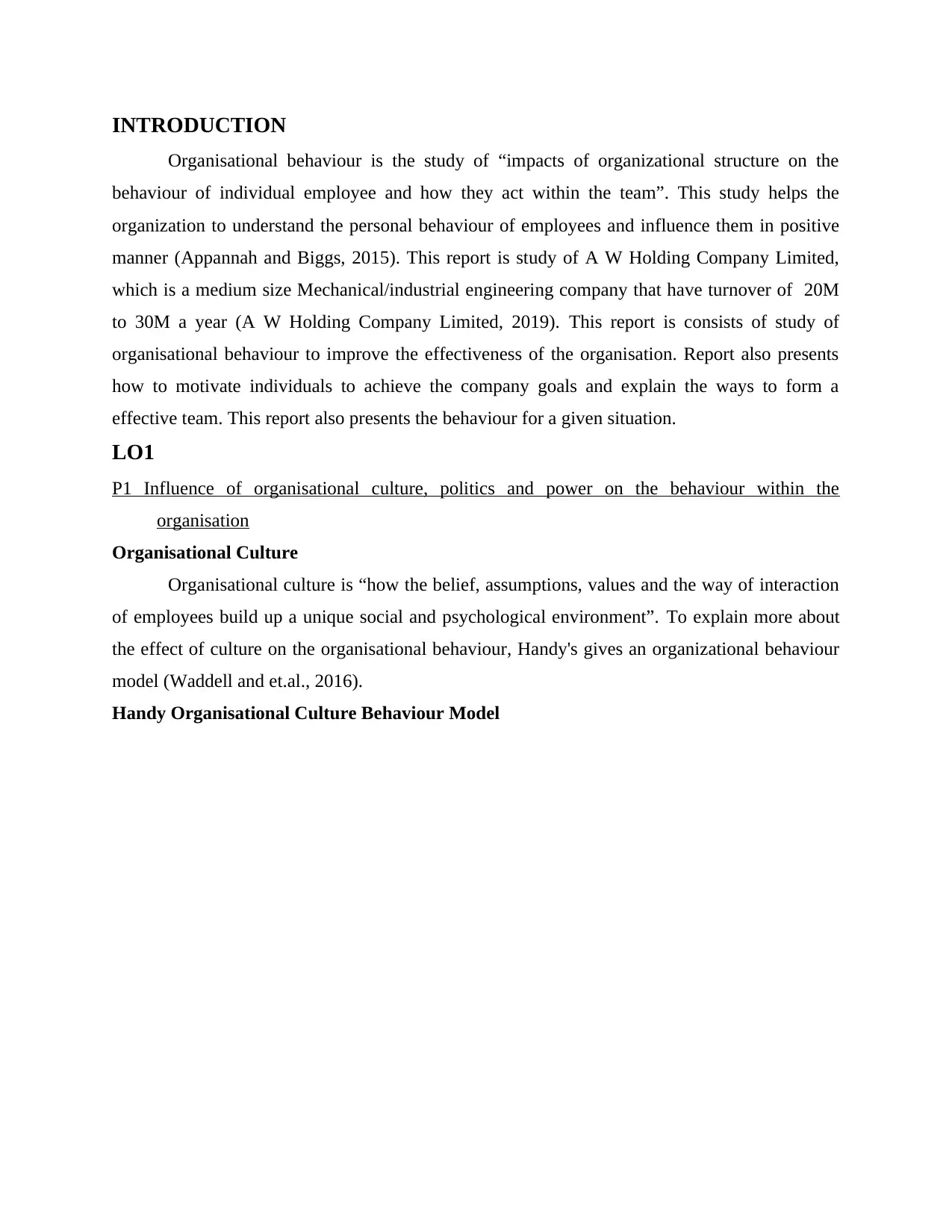
INTRODUCTION
Organisational behaviour is the study of “impacts of organizational structure on the
behaviour of individual employee and how they act within the team”. This study helps the
organization to understand the personal behaviour of employees and influence them in positive
manner (Appannah and Biggs, 2015). This report is study of A W Holding Company Limited,
which is a medium size Mechanical/industrial engineering company that have turnover of 20M
to 30M a year (A W Holding Company Limited, 2019). This report is consists of study of
organisational behaviour to improve the effectiveness of the organisation. Report also presents
how to motivate individuals to achieve the company goals and explain the ways to form a
effective team. This report also presents the behaviour for a given situation.
LO1
P1 Influence of organisational culture, politics and power on the behaviour within the
organisation
Organisational Culture
Organisational culture is “how the belief, assumptions, values and the way of interaction
of employees build up a unique social and psychological environment”. To explain more about
the effect of culture on the organisational behaviour, Handy's gives an organizational behaviour
model (Waddell and et.al., 2016).
Handy Organisational Culture Behaviour Model
Organisational behaviour is the study of “impacts of organizational structure on the
behaviour of individual employee and how they act within the team”. This study helps the
organization to understand the personal behaviour of employees and influence them in positive
manner (Appannah and Biggs, 2015). This report is study of A W Holding Company Limited,
which is a medium size Mechanical/industrial engineering company that have turnover of 20M
to 30M a year (A W Holding Company Limited, 2019). This report is consists of study of
organisational behaviour to improve the effectiveness of the organisation. Report also presents
how to motivate individuals to achieve the company goals and explain the ways to form a
effective team. This report also presents the behaviour for a given situation.
LO1
P1 Influence of organisational culture, politics and power on the behaviour within the
organisation
Organisational Culture
Organisational culture is “how the belief, assumptions, values and the way of interaction
of employees build up a unique social and psychological environment”. To explain more about
the effect of culture on the organisational behaviour, Handy's gives an organizational behaviour
model (Waddell and et.al., 2016).
Handy Organisational Culture Behaviour Model
⊘ This is a preview!⊘
Do you want full access?
Subscribe today to unlock all pages.

Trusted by 1+ million students worldwide
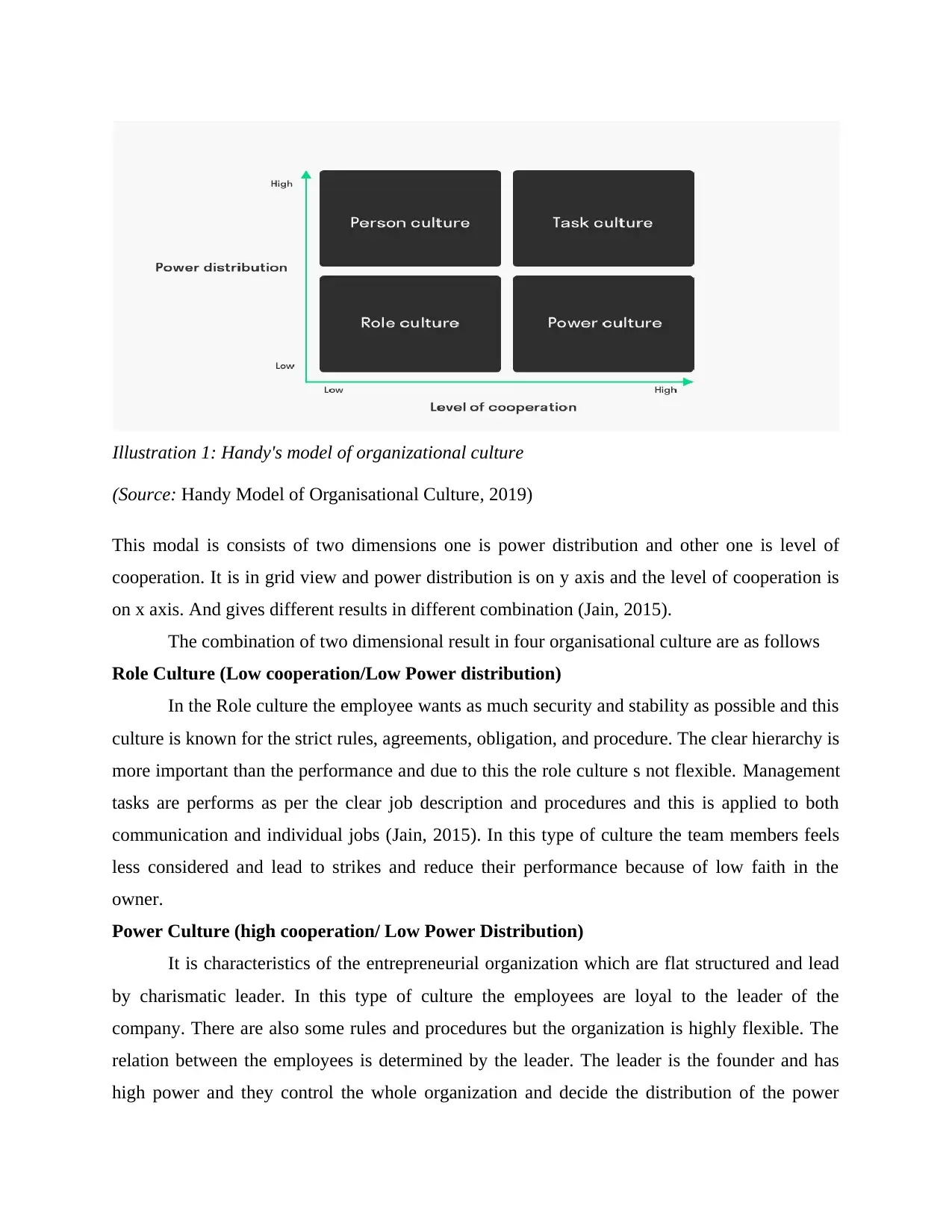
This modal is consists of two dimensions one is power distribution and other one is level of
cooperation. It is in grid view and power distribution is on y axis and the level of cooperation is
on x axis. And gives different results in different combination (Jain, 2015).
The combination of two dimensional result in four organisational culture are as follows
Role Culture (Low cooperation/Low Power distribution)
In the Role culture the employee wants as much security and stability as possible and this
culture is known for the strict rules, agreements, obligation, and procedure. The clear hierarchy is
more important than the performance and due to this the role culture s not flexible. Management
tasks are performs as per the clear job description and procedures and this is applied to both
communication and individual jobs (Jain, 2015). In this type of culture the team members feels
less considered and lead to strikes and reduce their performance because of low faith in the
owner.
Power Culture (high cooperation/ Low Power Distribution)
It is characteristics of the entrepreneurial organization which are flat structured and lead
by charismatic leader. In this type of culture the employees are loyal to the leader of the
company. There are also some rules and procedures but the organization is highly flexible. The
relation between the employees is determined by the leader. The leader is the founder and has
high power and they control the whole organization and decide the distribution of the power
Illustration 1: Handy's model of organizational culture
(Source: Handy Model of Organisational Culture, 2019)
cooperation. It is in grid view and power distribution is on y axis and the level of cooperation is
on x axis. And gives different results in different combination (Jain, 2015).
The combination of two dimensional result in four organisational culture are as follows
Role Culture (Low cooperation/Low Power distribution)
In the Role culture the employee wants as much security and stability as possible and this
culture is known for the strict rules, agreements, obligation, and procedure. The clear hierarchy is
more important than the performance and due to this the role culture s not flexible. Management
tasks are performs as per the clear job description and procedures and this is applied to both
communication and individual jobs (Jain, 2015). In this type of culture the team members feels
less considered and lead to strikes and reduce their performance because of low faith in the
owner.
Power Culture (high cooperation/ Low Power Distribution)
It is characteristics of the entrepreneurial organization which are flat structured and lead
by charismatic leader. In this type of culture the employees are loyal to the leader of the
company. There are also some rules and procedures but the organization is highly flexible. The
relation between the employees is determined by the leader. The leader is the founder and has
high power and they control the whole organization and decide the distribution of the power
Illustration 1: Handy's model of organizational culture
(Source: Handy Model of Organisational Culture, 2019)
Paraphrase This Document
Need a fresh take? Get an instant paraphrase of this document with our AI Paraphraser
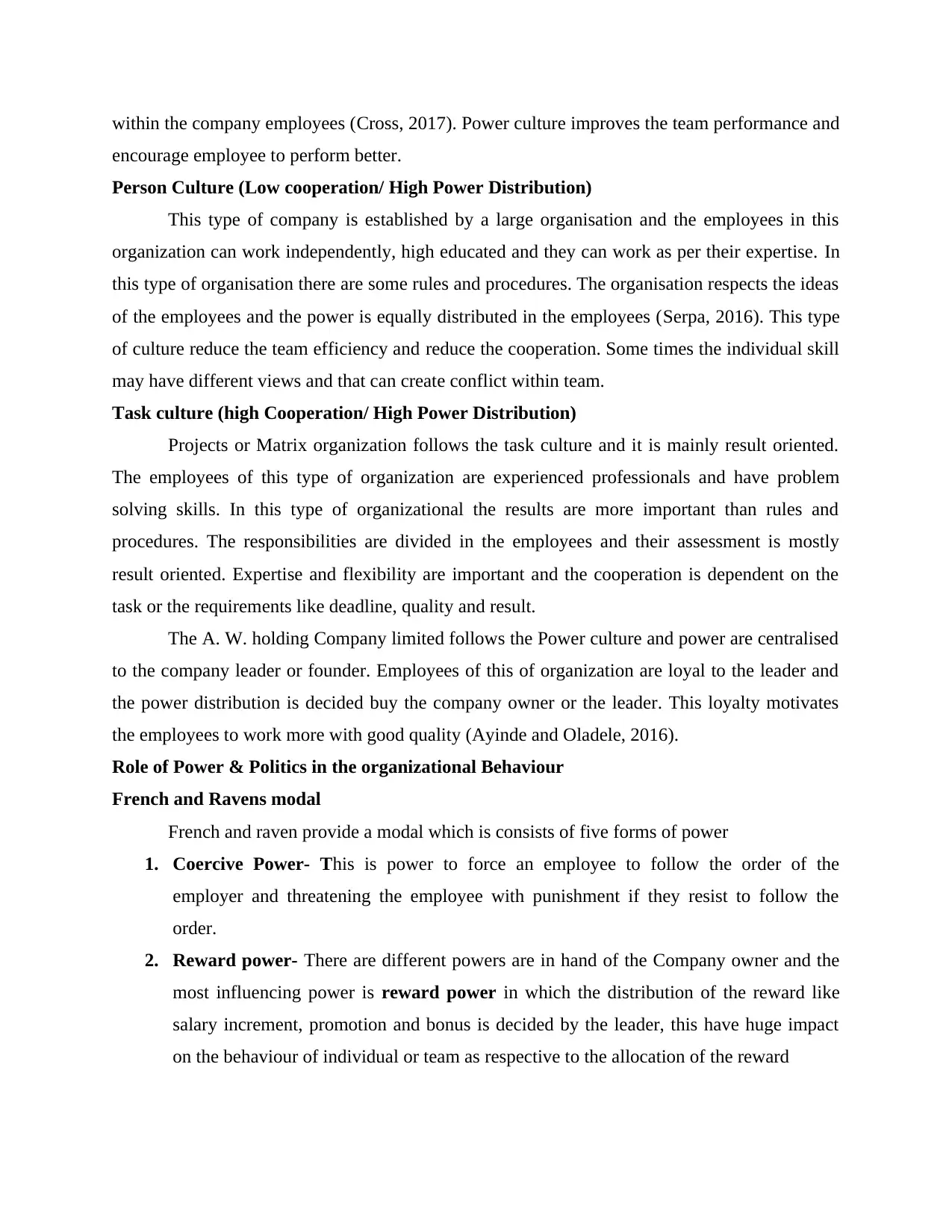
within the company employees (Cross, 2017). Power culture improves the team performance and
encourage employee to perform better.
Person Culture (Low cooperation/ High Power Distribution)
This type of company is established by a large organisation and the employees in this
organization can work independently, high educated and they can work as per their expertise. In
this type of organisation there are some rules and procedures. The organisation respects the ideas
of the employees and the power is equally distributed in the employees (Serpa, 2016). This type
of culture reduce the team efficiency and reduce the cooperation. Some times the individual skill
may have different views and that can create conflict within team.
Task culture (high Cooperation/ High Power Distribution)
Projects or Matrix organization follows the task culture and it is mainly result oriented.
The employees of this type of organization are experienced professionals and have problem
solving skills. In this type of organizational the results are more important than rules and
procedures. The responsibilities are divided in the employees and their assessment is mostly
result oriented. Expertise and flexibility are important and the cooperation is dependent on the
task or the requirements like deadline, quality and result.
The A. W. holding Company limited follows the Power culture and power are centralised
to the company leader or founder. Employees of this of organization are loyal to the leader and
the power distribution is decided buy the company owner or the leader. This loyalty motivates
the employees to work more with good quality (Ayinde and Oladele, 2016).
Role of Power & Politics in the organizational Behaviour
French and Ravens modal
French and raven provide a modal which is consists of five forms of power
1. Coercive Power- This is power to force an employee to follow the order of the
employer and threatening the employee with punishment if they resist to follow the
order.
2. Reward power- There are different powers are in hand of the Company owner and the
most influencing power is reward power in which the distribution of the reward like
salary increment, promotion and bonus is decided by the leader, this have huge impact
on the behaviour of individual or team as respective to the allocation of the reward
encourage employee to perform better.
Person Culture (Low cooperation/ High Power Distribution)
This type of company is established by a large organisation and the employees in this
organization can work independently, high educated and they can work as per their expertise. In
this type of organisation there are some rules and procedures. The organisation respects the ideas
of the employees and the power is equally distributed in the employees (Serpa, 2016). This type
of culture reduce the team efficiency and reduce the cooperation. Some times the individual skill
may have different views and that can create conflict within team.
Task culture (high Cooperation/ High Power Distribution)
Projects or Matrix organization follows the task culture and it is mainly result oriented.
The employees of this type of organization are experienced professionals and have problem
solving skills. In this type of organizational the results are more important than rules and
procedures. The responsibilities are divided in the employees and their assessment is mostly
result oriented. Expertise and flexibility are important and the cooperation is dependent on the
task or the requirements like deadline, quality and result.
The A. W. holding Company limited follows the Power culture and power are centralised
to the company leader or founder. Employees of this of organization are loyal to the leader and
the power distribution is decided buy the company owner or the leader. This loyalty motivates
the employees to work more with good quality (Ayinde and Oladele, 2016).
Role of Power & Politics in the organizational Behaviour
French and Ravens modal
French and raven provide a modal which is consists of five forms of power
1. Coercive Power- This is power to force an employee to follow the order of the
employer and threatening the employee with punishment if they resist to follow the
order.
2. Reward power- There are different powers are in hand of the Company owner and the
most influencing power is reward power in which the distribution of the reward like
salary increment, promotion and bonus is decided by the leader, this have huge impact
on the behaviour of individual or team as respective to the allocation of the reward
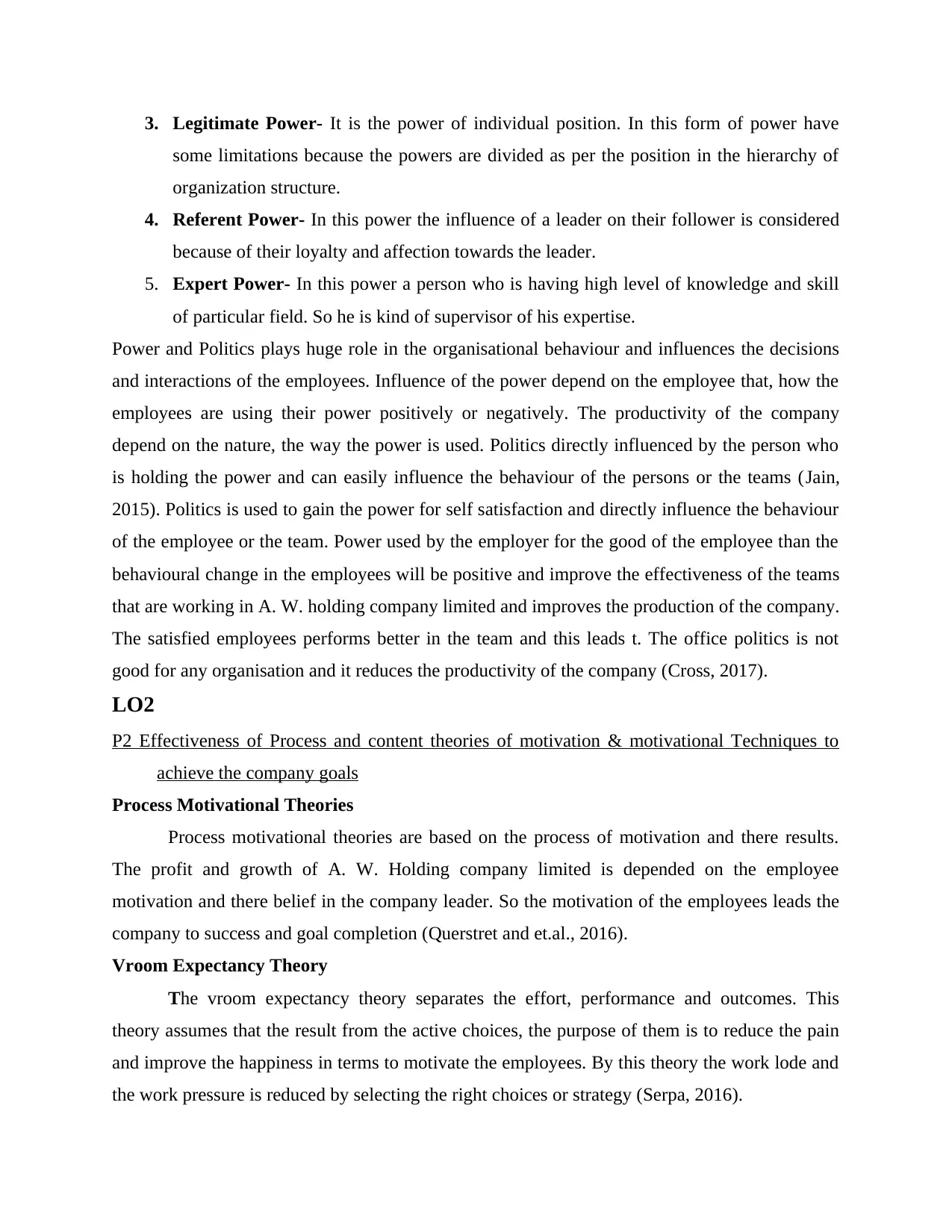
3. Legitimate Power- It is the power of individual position. In this form of power have
some limitations because the powers are divided as per the position in the hierarchy of
organization structure.
4. Referent Power- In this power the influence of a leader on their follower is considered
because of their loyalty and affection towards the leader.
5. Expert Power- In this power a person who is having high level of knowledge and skill
of particular field. So he is kind of supervisor of his expertise.
Power and Politics plays huge role in the organisational behaviour and influences the decisions
and interactions of the employees. Influence of the power depend on the employee that, how the
employees are using their power positively or negatively. The productivity of the company
depend on the nature, the way the power is used. Politics directly influenced by the person who
is holding the power and can easily influence the behaviour of the persons or the teams (Jain,
2015). Politics is used to gain the power for self satisfaction and directly influence the behaviour
of the employee or the team. Power used by the employer for the good of the employee than the
behavioural change in the employees will be positive and improve the effectiveness of the teams
that are working in A. W. holding company limited and improves the production of the company.
The satisfied employees performs better in the team and this leads t. The office politics is not
good for any organisation and it reduces the productivity of the company (Cross, 2017).
LO2
P2 Effectiveness of Process and content theories of motivation & motivational Techniques to
achieve the company goals
Process Motivational Theories
Process motivational theories are based on the process of motivation and there results.
The profit and growth of A. W. Holding company limited is depended on the employee
motivation and there belief in the company leader. So the motivation of the employees leads the
company to success and goal completion (Querstret and et.al., 2016).
Vroom Expectancy Theory
The vroom expectancy theory separates the effort, performance and outcomes. This
theory assumes that the result from the active choices, the purpose of them is to reduce the pain
and improve the happiness in terms to motivate the employees. By this theory the work lode and
the work pressure is reduced by selecting the right choices or strategy (Serpa, 2016).
some limitations because the powers are divided as per the position in the hierarchy of
organization structure.
4. Referent Power- In this power the influence of a leader on their follower is considered
because of their loyalty and affection towards the leader.
5. Expert Power- In this power a person who is having high level of knowledge and skill
of particular field. So he is kind of supervisor of his expertise.
Power and Politics plays huge role in the organisational behaviour and influences the decisions
and interactions of the employees. Influence of the power depend on the employee that, how the
employees are using their power positively or negatively. The productivity of the company
depend on the nature, the way the power is used. Politics directly influenced by the person who
is holding the power and can easily influence the behaviour of the persons or the teams (Jain,
2015). Politics is used to gain the power for self satisfaction and directly influence the behaviour
of the employee or the team. Power used by the employer for the good of the employee than the
behavioural change in the employees will be positive and improve the effectiveness of the teams
that are working in A. W. holding company limited and improves the production of the company.
The satisfied employees performs better in the team and this leads t. The office politics is not
good for any organisation and it reduces the productivity of the company (Cross, 2017).
LO2
P2 Effectiveness of Process and content theories of motivation & motivational Techniques to
achieve the company goals
Process Motivational Theories
Process motivational theories are based on the process of motivation and there results.
The profit and growth of A. W. Holding company limited is depended on the employee
motivation and there belief in the company leader. So the motivation of the employees leads the
company to success and goal completion (Querstret and et.al., 2016).
Vroom Expectancy Theory
The vroom expectancy theory separates the effort, performance and outcomes. This
theory assumes that the result from the active choices, the purpose of them is to reduce the pain
and improve the happiness in terms to motivate the employees. By this theory the work lode and
the work pressure is reduced by selecting the right choices or strategy (Serpa, 2016).
⊘ This is a preview!⊘
Do you want full access?
Subscribe today to unlock all pages.

Trusted by 1+ million students worldwide
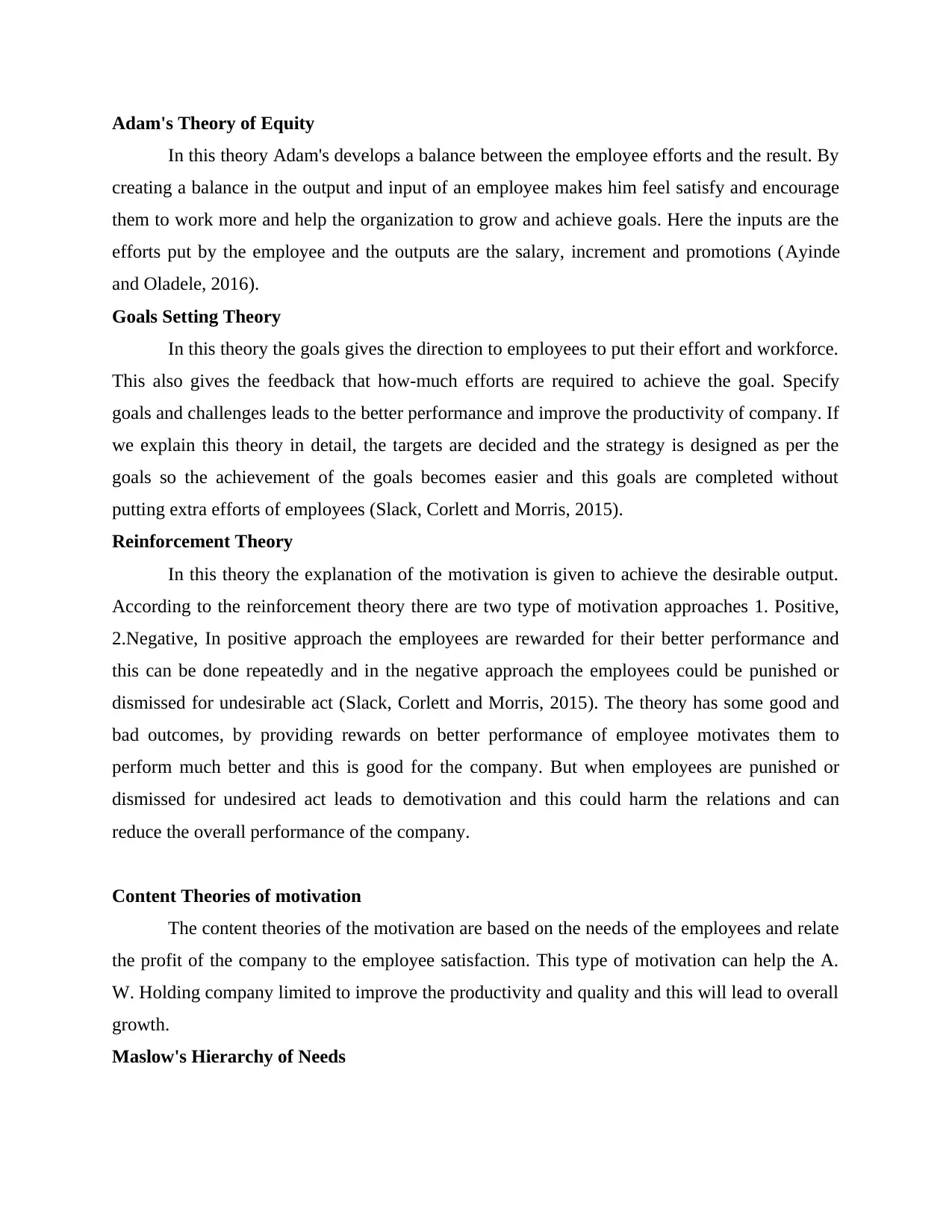
Adam's Theory of Equity
In this theory Adam's develops a balance between the employee efforts and the result. By
creating a balance in the output and input of an employee makes him feel satisfy and encourage
them to work more and help the organization to grow and achieve goals. Here the inputs are the
efforts put by the employee and the outputs are the salary, increment and promotions (Ayinde
and Oladele, 2016).
Goals Setting Theory
In this theory the goals gives the direction to employees to put their effort and workforce.
This also gives the feedback that how-much efforts are required to achieve the goal. Specify
goals and challenges leads to the better performance and improve the productivity of company. If
we explain this theory in detail, the targets are decided and the strategy is designed as per the
goals so the achievement of the goals becomes easier and this goals are completed without
putting extra efforts of employees (Slack, Corlett and Morris, 2015).
Reinforcement Theory
In this theory the explanation of the motivation is given to achieve the desirable output.
According to the reinforcement theory there are two type of motivation approaches 1. Positive,
2.Negative, In positive approach the employees are rewarded for their better performance and
this can be done repeatedly and in the negative approach the employees could be punished or
dismissed for undesirable act (Slack, Corlett and Morris, 2015). The theory has some good and
bad outcomes, by providing rewards on better performance of employee motivates them to
perform much better and this is good for the company. But when employees are punished or
dismissed for undesired act leads to demotivation and this could harm the relations and can
reduce the overall performance of the company.
Content Theories of motivation
The content theories of the motivation are based on the needs of the employees and relate
the profit of the company to the employee satisfaction. This type of motivation can help the A.
W. Holding company limited to improve the productivity and quality and this will lead to overall
growth.
Maslow's Hierarchy of Needs
In this theory Adam's develops a balance between the employee efforts and the result. By
creating a balance in the output and input of an employee makes him feel satisfy and encourage
them to work more and help the organization to grow and achieve goals. Here the inputs are the
efforts put by the employee and the outputs are the salary, increment and promotions (Ayinde
and Oladele, 2016).
Goals Setting Theory
In this theory the goals gives the direction to employees to put their effort and workforce.
This also gives the feedback that how-much efforts are required to achieve the goal. Specify
goals and challenges leads to the better performance and improve the productivity of company. If
we explain this theory in detail, the targets are decided and the strategy is designed as per the
goals so the achievement of the goals becomes easier and this goals are completed without
putting extra efforts of employees (Slack, Corlett and Morris, 2015).
Reinforcement Theory
In this theory the explanation of the motivation is given to achieve the desirable output.
According to the reinforcement theory there are two type of motivation approaches 1. Positive,
2.Negative, In positive approach the employees are rewarded for their better performance and
this can be done repeatedly and in the negative approach the employees could be punished or
dismissed for undesirable act (Slack, Corlett and Morris, 2015). The theory has some good and
bad outcomes, by providing rewards on better performance of employee motivates them to
perform much better and this is good for the company. But when employees are punished or
dismissed for undesired act leads to demotivation and this could harm the relations and can
reduce the overall performance of the company.
Content Theories of motivation
The content theories of the motivation are based on the needs of the employees and relate
the profit of the company to the employee satisfaction. This type of motivation can help the A.
W. Holding company limited to improve the productivity and quality and this will lead to overall
growth.
Maslow's Hierarchy of Needs
Paraphrase This Document
Need a fresh take? Get an instant paraphrase of this document with our AI Paraphraser
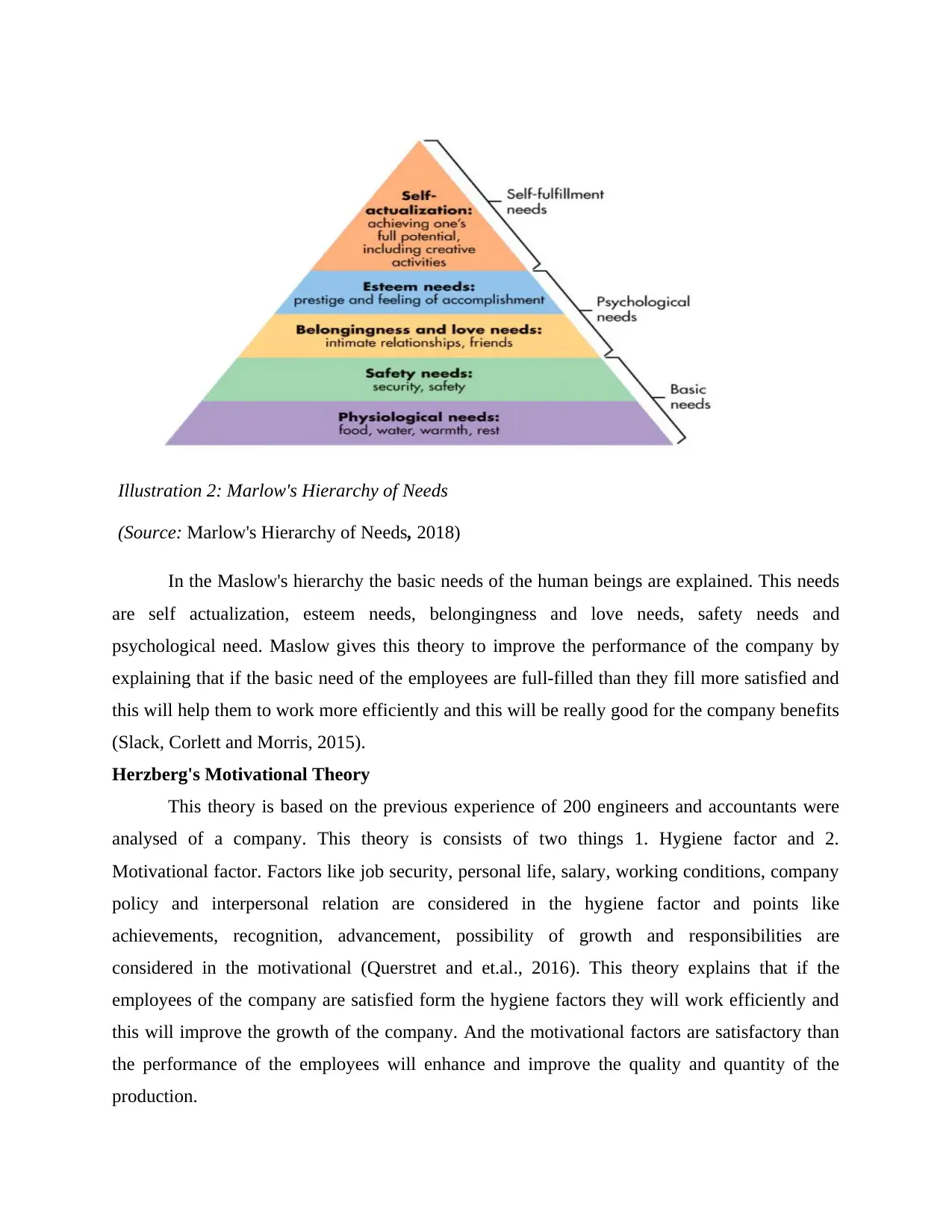
In the Maslow's hierarchy the basic needs of the human beings are explained. This needs
are self actualization, esteem needs, belongingness and love needs, safety needs and
psychological need. Maslow gives this theory to improve the performance of the company by
explaining that if the basic need of the employees are full-filled than they fill more satisfied and
this will help them to work more efficiently and this will be really good for the company benefits
(Slack, Corlett and Morris, 2015).
Herzberg's Motivational Theory
This theory is based on the previous experience of 200 engineers and accountants were
analysed of a company. This theory is consists of two things 1. Hygiene factor and 2.
Motivational factor. Factors like job security, personal life, salary, working conditions, company
policy and interpersonal relation are considered in the hygiene factor and points like
achievements, recognition, advancement, possibility of growth and responsibilities are
considered in the motivational (Querstret and et.al., 2016). This theory explains that if the
employees of the company are satisfied form the hygiene factors they will work efficiently and
this will improve the growth of the company. And the motivational factors are satisfactory than
the performance of the employees will enhance and improve the quality and quantity of the
production.
Illustration 2: Marlow's Hierarchy of Needs
(Source: Marlow's Hierarchy of Needs, 2018)
are self actualization, esteem needs, belongingness and love needs, safety needs and
psychological need. Maslow gives this theory to improve the performance of the company by
explaining that if the basic need of the employees are full-filled than they fill more satisfied and
this will help them to work more efficiently and this will be really good for the company benefits
(Slack, Corlett and Morris, 2015).
Herzberg's Motivational Theory
This theory is based on the previous experience of 200 engineers and accountants were
analysed of a company. This theory is consists of two things 1. Hygiene factor and 2.
Motivational factor. Factors like job security, personal life, salary, working conditions, company
policy and interpersonal relation are considered in the hygiene factor and points like
achievements, recognition, advancement, possibility of growth and responsibilities are
considered in the motivational (Querstret and et.al., 2016). This theory explains that if the
employees of the company are satisfied form the hygiene factors they will work efficiently and
this will improve the growth of the company. And the motivational factors are satisfactory than
the performance of the employees will enhance and improve the quality and quantity of the
production.
Illustration 2: Marlow's Hierarchy of Needs
(Source: Marlow's Hierarchy of Needs, 2018)
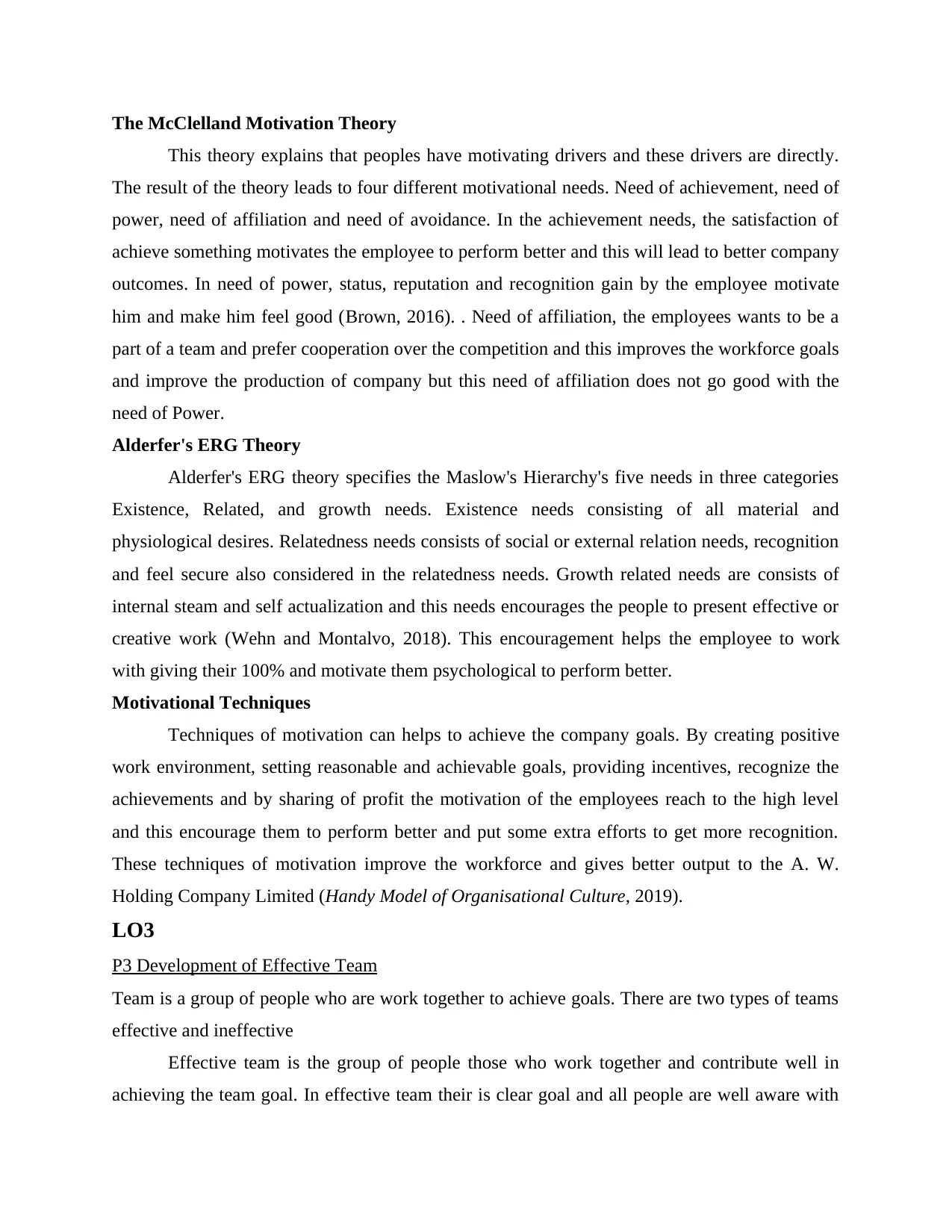
The McClelland Motivation Theory
This theory explains that peoples have motivating drivers and these drivers are directly.
The result of the theory leads to four different motivational needs. Need of achievement, need of
power, need of affiliation and need of avoidance. In the achievement needs, the satisfaction of
achieve something motivates the employee to perform better and this will lead to better company
outcomes. In need of power, status, reputation and recognition gain by the employee motivate
him and make him feel good (Brown, 2016). . Need of affiliation, the employees wants to be a
part of a team and prefer cooperation over the competition and this improves the workforce goals
and improve the production of company but this need of affiliation does not go good with the
need of Power.
Alderfer's ERG Theory
Alderfer's ERG theory specifies the Maslow's Hierarchy's five needs in three categories
Existence, Related, and growth needs. Existence needs consisting of all material and
physiological desires. Relatedness needs consists of social or external relation needs, recognition
and feel secure also considered in the relatedness needs. Growth related needs are consists of
internal steam and self actualization and this needs encourages the people to present effective or
creative work (Wehn and Montalvo, 2018). This encouragement helps the employee to work
with giving their 100% and motivate them psychological to perform better.
Motivational Techniques
Techniques of motivation can helps to achieve the company goals. By creating positive
work environment, setting reasonable and achievable goals, providing incentives, recognize the
achievements and by sharing of profit the motivation of the employees reach to the high level
and this encourage them to perform better and put some extra efforts to get more recognition.
These techniques of motivation improve the workforce and gives better output to the A. W.
Holding Company Limited (Handy Model of Organisational Culture, 2019).
LO3
P3 Development of Effective Team
Team is a group of people who are work together to achieve goals. There are two types of teams
effective and ineffective
Effective team is the group of people those who work together and contribute well in
achieving the team goal. In effective team their is clear goal and all people are well aware with
This theory explains that peoples have motivating drivers and these drivers are directly.
The result of the theory leads to four different motivational needs. Need of achievement, need of
power, need of affiliation and need of avoidance. In the achievement needs, the satisfaction of
achieve something motivates the employee to perform better and this will lead to better company
outcomes. In need of power, status, reputation and recognition gain by the employee motivate
him and make him feel good (Brown, 2016). . Need of affiliation, the employees wants to be a
part of a team and prefer cooperation over the competition and this improves the workforce goals
and improve the production of company but this need of affiliation does not go good with the
need of Power.
Alderfer's ERG Theory
Alderfer's ERG theory specifies the Maslow's Hierarchy's five needs in three categories
Existence, Related, and growth needs. Existence needs consisting of all material and
physiological desires. Relatedness needs consists of social or external relation needs, recognition
and feel secure also considered in the relatedness needs. Growth related needs are consists of
internal steam and self actualization and this needs encourages the people to present effective or
creative work (Wehn and Montalvo, 2018). This encouragement helps the employee to work
with giving their 100% and motivate them psychological to perform better.
Motivational Techniques
Techniques of motivation can helps to achieve the company goals. By creating positive
work environment, setting reasonable and achievable goals, providing incentives, recognize the
achievements and by sharing of profit the motivation of the employees reach to the high level
and this encourage them to perform better and put some extra efforts to get more recognition.
These techniques of motivation improve the workforce and gives better output to the A. W.
Holding Company Limited (Handy Model of Organisational Culture, 2019).
LO3
P3 Development of Effective Team
Team is a group of people who are work together to achieve goals. There are two types of teams
effective and ineffective
Effective team is the group of people those who work together and contribute well in
achieving the team goal. In effective team their is clear goal and all people are well aware with
⊘ This is a preview!⊘
Do you want full access?
Subscribe today to unlock all pages.

Trusted by 1+ million students worldwide
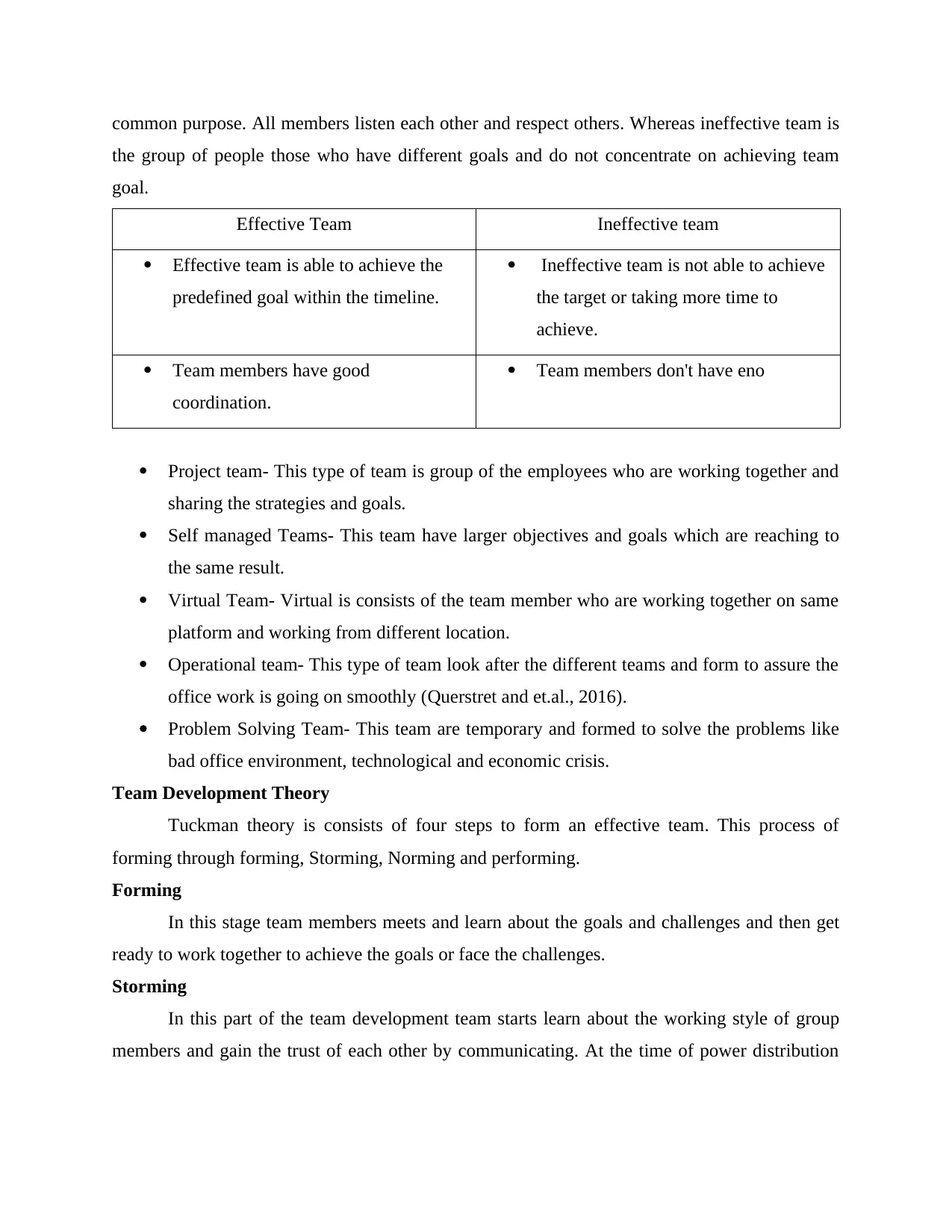
common purpose. All members listen each other and respect others. Whereas ineffective team is
the group of people those who have different goals and do not concentrate on achieving team
goal.
Effective Team Ineffective team
Effective team is able to achieve the
predefined goal within the timeline.
Ineffective team is not able to achieve
the target or taking more time to
achieve.
Team members have good
coordination.
Team members don't have eno
Project team- This type of team is group of the employees who are working together and
sharing the strategies and goals.
Self managed Teams- This team have larger objectives and goals which are reaching to
the same result.
Virtual Team- Virtual is consists of the team member who are working together on same
platform and working from different location.
Operational team- This type of team look after the different teams and form to assure the
office work is going on smoothly (Querstret and et.al., 2016).
Problem Solving Team- This team are temporary and formed to solve the problems like
bad office environment, technological and economic crisis.
Team Development Theory
Tuckman theory is consists of four steps to form an effective team. This process of
forming through forming, Storming, Norming and performing.
Forming
In this stage team members meets and learn about the goals and challenges and then get
ready to work together to achieve the goals or face the challenges.
Storming
In this part of the team development team starts learn about the working style of group
members and gain the trust of each other by communicating. At the time of power distribution
the group of people those who have different goals and do not concentrate on achieving team
goal.
Effective Team Ineffective team
Effective team is able to achieve the
predefined goal within the timeline.
Ineffective team is not able to achieve
the target or taking more time to
achieve.
Team members have good
coordination.
Team members don't have eno
Project team- This type of team is group of the employees who are working together and
sharing the strategies and goals.
Self managed Teams- This team have larger objectives and goals which are reaching to
the same result.
Virtual Team- Virtual is consists of the team member who are working together on same
platform and working from different location.
Operational team- This type of team look after the different teams and form to assure the
office work is going on smoothly (Querstret and et.al., 2016).
Problem Solving Team- This team are temporary and formed to solve the problems like
bad office environment, technological and economic crisis.
Team Development Theory
Tuckman theory is consists of four steps to form an effective team. This process of
forming through forming, Storming, Norming and performing.
Forming
In this stage team members meets and learn about the goals and challenges and then get
ready to work together to achieve the goals or face the challenges.
Storming
In this part of the team development team starts learn about the working style of group
members and gain the trust of each other by communicating. At the time of power distribution
Paraphrase This Document
Need a fresh take? Get an instant paraphrase of this document with our AI Paraphraser
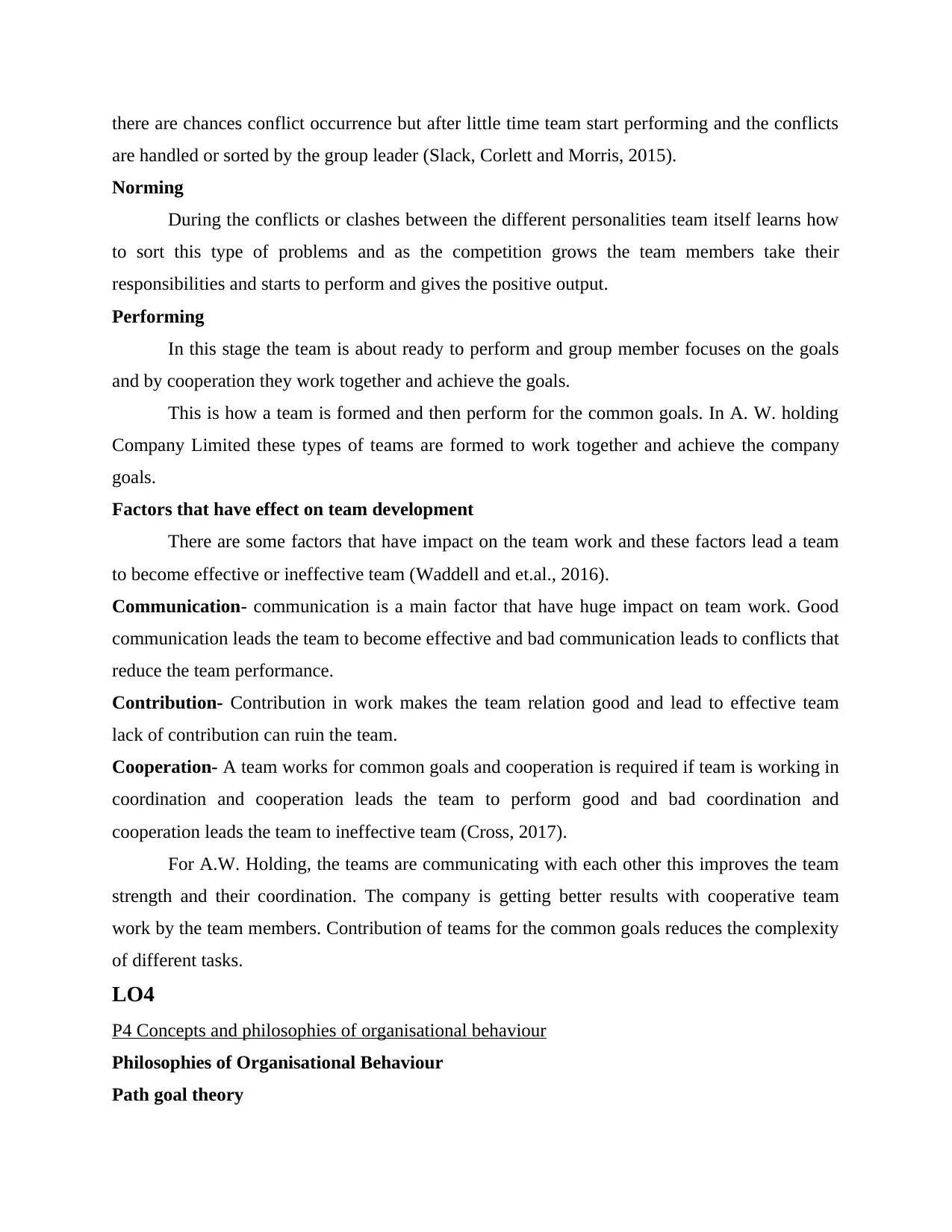
there are chances conflict occurrence but after little time team start performing and the conflicts
are handled or sorted by the group leader (Slack, Corlett and Morris, 2015).
Norming
During the conflicts or clashes between the different personalities team itself learns how
to sort this type of problems and as the competition grows the team members take their
responsibilities and starts to perform and gives the positive output.
Performing
In this stage the team is about ready to perform and group member focuses on the goals
and by cooperation they work together and achieve the goals.
This is how a team is formed and then perform for the common goals. In A. W. holding
Company Limited these types of teams are formed to work together and achieve the company
goals.
Factors that have effect on team development
There are some factors that have impact on the team work and these factors lead a team
to become effective or ineffective team (Waddell and et.al., 2016).
Communication- communication is a main factor that have huge impact on team work. Good
communication leads the team to become effective and bad communication leads to conflicts that
reduce the team performance.
Contribution- Contribution in work makes the team relation good and lead to effective team
lack of contribution can ruin the team.
Cooperation- A team works for common goals and cooperation is required if team is working in
coordination and cooperation leads the team to perform good and bad coordination and
cooperation leads the team to ineffective team (Cross, 2017).
For A.W. Holding, the teams are communicating with each other this improves the team
strength and their coordination. The company is getting better results with cooperative team
work by the team members. Contribution of teams for the common goals reduces the complexity
of different tasks.
LO4
P4 Concepts and philosophies of organisational behaviour
Philosophies of Organisational Behaviour
Path goal theory
are handled or sorted by the group leader (Slack, Corlett and Morris, 2015).
Norming
During the conflicts or clashes between the different personalities team itself learns how
to sort this type of problems and as the competition grows the team members take their
responsibilities and starts to perform and gives the positive output.
Performing
In this stage the team is about ready to perform and group member focuses on the goals
and by cooperation they work together and achieve the goals.
This is how a team is formed and then perform for the common goals. In A. W. holding
Company Limited these types of teams are formed to work together and achieve the company
goals.
Factors that have effect on team development
There are some factors that have impact on the team work and these factors lead a team
to become effective or ineffective team (Waddell and et.al., 2016).
Communication- communication is a main factor that have huge impact on team work. Good
communication leads the team to become effective and bad communication leads to conflicts that
reduce the team performance.
Contribution- Contribution in work makes the team relation good and lead to effective team
lack of contribution can ruin the team.
Cooperation- A team works for common goals and cooperation is required if team is working in
coordination and cooperation leads the team to perform good and bad coordination and
cooperation leads the team to ineffective team (Cross, 2017).
For A.W. Holding, the teams are communicating with each other this improves the team
strength and their coordination. The company is getting better results with cooperative team
work by the team members. Contribution of teams for the common goals reduces the complexity
of different tasks.
LO4
P4 Concepts and philosophies of organisational behaviour
Philosophies of Organisational Behaviour
Path goal theory
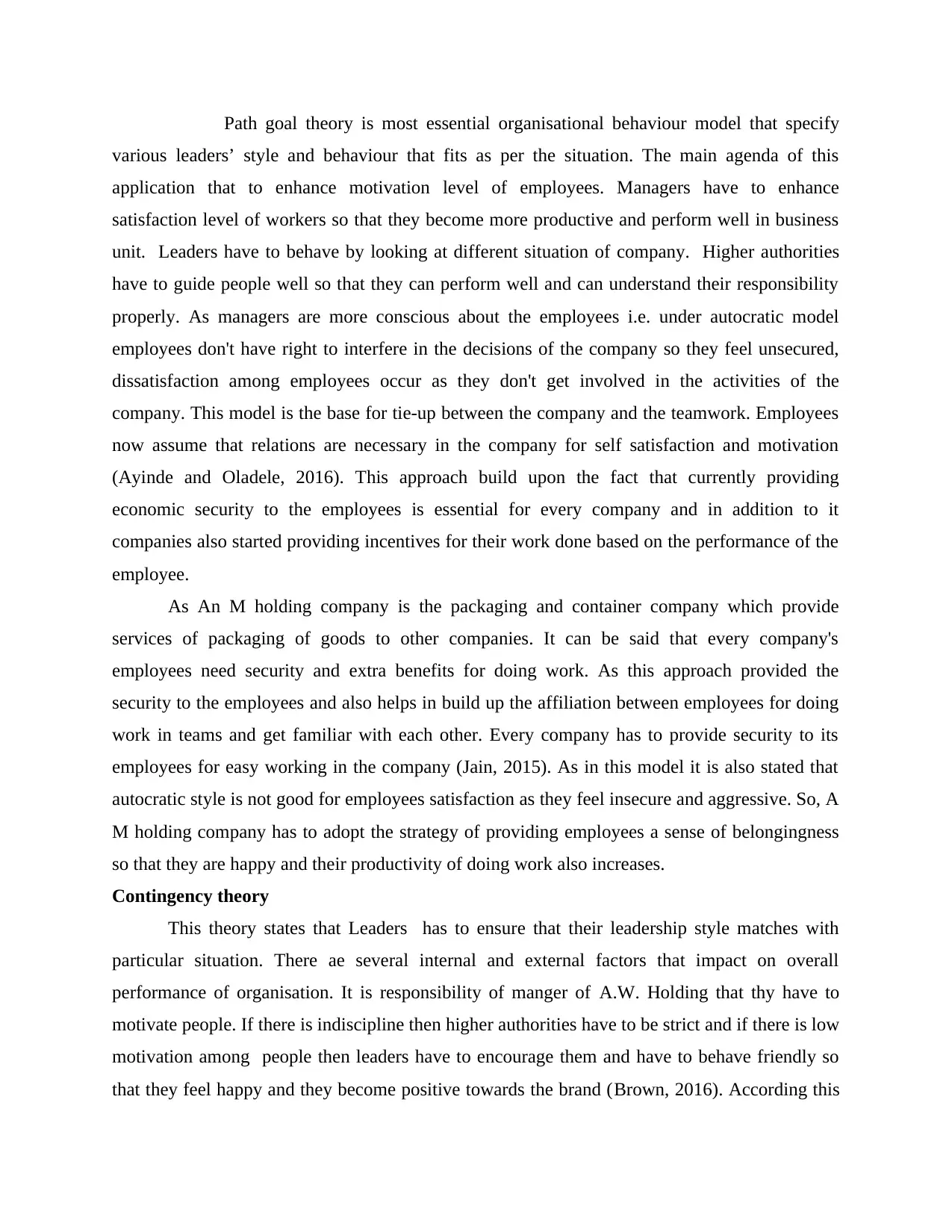
Path goal theory is most essential organisational behaviour model that specify
various leaders’ style and behaviour that fits as per the situation. The main agenda of this
application that to enhance motivation level of employees. Managers have to enhance
satisfaction level of workers so that they become more productive and perform well in business
unit. Leaders have to behave by looking at different situation of company. Higher authorities
have to guide people well so that they can perform well and can understand their responsibility
properly. As managers are more conscious about the employees i.e. under autocratic model
employees don't have right to interfere in the decisions of the company so they feel unsecured,
dissatisfaction among employees occur as they don't get involved in the activities of the
company. This model is the base for tie-up between the company and the teamwork. Employees
now assume that relations are necessary in the company for self satisfaction and motivation
(Ayinde and Oladele, 2016). This approach build upon the fact that currently providing
economic security to the employees is essential for every company and in addition to it
companies also started providing incentives for their work done based on the performance of the
employee.
As An M holding company is the packaging and container company which provide
services of packaging of goods to other companies. It can be said that every company's
employees need security and extra benefits for doing work. As this approach provided the
security to the employees and also helps in build up the affiliation between employees for doing
work in teams and get familiar with each other. Every company has to provide security to its
employees for easy working in the company (Jain, 2015). As in this model it is also stated that
autocratic style is not good for employees satisfaction as they feel insecure and aggressive. So, A
M holding company has to adopt the strategy of providing employees a sense of belongingness
so that they are happy and their productivity of doing work also increases.
Contingency theory
This theory states that Leaders has to ensure that their leadership style matches with
particular situation. There ae several internal and external factors that impact on overall
performance of organisation. It is responsibility of manger of A.W. Holding that thy have to
motivate people. If there is indiscipline then higher authorities have to be strict and if there is low
motivation among people then leaders have to encourage them and have to behave friendly so
that they feel happy and they become positive towards the brand (Brown, 2016). According this
various leaders’ style and behaviour that fits as per the situation. The main agenda of this
application that to enhance motivation level of employees. Managers have to enhance
satisfaction level of workers so that they become more productive and perform well in business
unit. Leaders have to behave by looking at different situation of company. Higher authorities
have to guide people well so that they can perform well and can understand their responsibility
properly. As managers are more conscious about the employees i.e. under autocratic model
employees don't have right to interfere in the decisions of the company so they feel unsecured,
dissatisfaction among employees occur as they don't get involved in the activities of the
company. This model is the base for tie-up between the company and the teamwork. Employees
now assume that relations are necessary in the company for self satisfaction and motivation
(Ayinde and Oladele, 2016). This approach build upon the fact that currently providing
economic security to the employees is essential for every company and in addition to it
companies also started providing incentives for their work done based on the performance of the
employee.
As An M holding company is the packaging and container company which provide
services of packaging of goods to other companies. It can be said that every company's
employees need security and extra benefits for doing work. As this approach provided the
security to the employees and also helps in build up the affiliation between employees for doing
work in teams and get familiar with each other. Every company has to provide security to its
employees for easy working in the company (Jain, 2015). As in this model it is also stated that
autocratic style is not good for employees satisfaction as they feel insecure and aggressive. So, A
M holding company has to adopt the strategy of providing employees a sense of belongingness
so that they are happy and their productivity of doing work also increases.
Contingency theory
This theory states that Leaders has to ensure that their leadership style matches with
particular situation. There ae several internal and external factors that impact on overall
performance of organisation. It is responsibility of manger of A.W. Holding that thy have to
motivate people. If there is indiscipline then higher authorities have to be strict and if there is low
motivation among people then leaders have to encourage them and have to behave friendly so
that they feel happy and they become positive towards the brand (Brown, 2016). According this
⊘ This is a preview!⊘
Do you want full access?
Subscribe today to unlock all pages.

Trusted by 1+ million students worldwide
1 out of 15
Related Documents
Your All-in-One AI-Powered Toolkit for Academic Success.
+13062052269
info@desklib.com
Available 24*7 on WhatsApp / Email
![[object Object]](/_next/static/media/star-bottom.7253800d.svg)
Unlock your academic potential
Copyright © 2020–2025 A2Z Services. All Rights Reserved. Developed and managed by ZUCOL.




